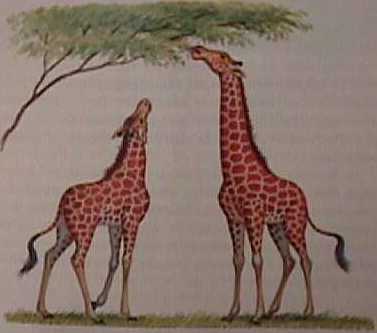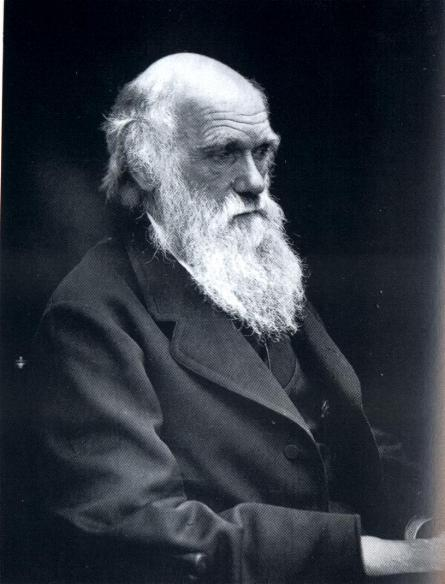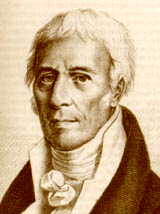A Webquest for 10th Grade Biology
Designed by
Michael Ouimet
mouimet@gw.neric.org

Introduction Task Process Evaulation Conclusion Credits
Lesson Plan Table of Contents
Introduction
In the 1800's, there were two major theories presented on evolution. One was described by Charles Darwin and the other by Jean Baptiste Lamarck. Some questions that could be answered by the theories might sound like this, "Did giraffes get their long necks by stretching and then passing that trait to offsrping? Did giraffes get their long necks through a series of small changes that took place over thousands of years? If I lift weights and get big mucles, will my children have big muscles? Why are humans and chimpanzees so similar?"

 Darwin
Lamarck
Darwin
Lamarck How did these
theories come about? What are some aspects of each theory?
Which theory do we believe today?
Task
Today, for those of us that believe in evolution, there is only one theory that seems accurate. In this webquest, you will mainly focus on which theory we believe today, as well as some components of this theory. You will have series of websites to look at and questions that go long with the websites. At the end of this webquest, you will create an image in Powerpoint depicting the scientific community's view of evolution.
Which theory do we believe today?
Task
Today, for those of us that believe in evolution, there is only one theory that seems accurate. In this webquest, you will mainly focus on which theory we believe today, as well as some components of this theory. You will have series of websites to look at and questions that go long with the websites. At the end of this webquest, you will create an image in Powerpoint depicting the scientific community's view of evolution.
The Process
1. Each student will work on this webquest individually.
2. You will answer the questions by going to the websites that I have picked out.
3. You will answer the question on the attached answer sheet and then print it out.
4. Use the webpage called Darwin and Natural Selection to answer the following questions.
a. What county was Charles Darwin from?
b. Which islands did Darwin visit and make many observations?
c. Describe Darwin's theory of Natural Selection.
5. Look under the heading "Lamarck's Scientific Thought"from the webpage called Jean-Baptiste Lamarck to answer the following questions.
d. What did Lamarck mean by "use and disuse"?
e. Could these acquired traits be passed on to offspring?
f. How many generations did it take to see a change?
6. Use the webpage called Adaptation: Mimicry and Protective Coloration to answer the following questions.
g. What is mimicry?
h. What are some other ways that organisms tryo to avoid predators?
7. On the webpage The Arts of Deception: Mimicry and Camouflage , look under the heading "Camouflage" to answer the folowwing questions.
i. Why might an organism want to be camouflaged?
The next section deals with some of the evidence for evolution.
8. Based on the picture and its caption, from the website on Homologous Structures ,
j. what do you think homologous structures are?
9. Whales have pelvic bones. Pelvic bones allow legs to atach to the body. Use the webpage on Vestgial Structures to
k. decide why whales may have needed pelvic bones in the past.
10. Once you have completed these questions, create an image, animation, cartoon strip, etc. that explains and shows the main ideas of natural slection. Create this document using Powerpoint. When you have completed it, e-mail to me at mouimet@gw.neric.org.
Evaluation
You will be graded according to the following rubric.
| Objective |
1 point |
2 points |
3 points |
| Differentiate between Darwin's and Lamarck's theories on evolution. |
answers
are missing key components |
information
is there but not coherentl written |
all
necessary information about the theories is present |
| Define some basic evolutionary terms such as mimicry, camouflage, and natural selection. |
1 term is
defined |
2 terms
are defined |
3 terms
are defined |
| Explain some of the evidnece for evolution. |
picture
of homologous structures is explained but definition is not given |
criterion
1 and whale pelvis is explained |
criteria
1 and 2 and homologous structures is correctly defined |
| Take notes and gather data from nonprint sources. |
1 - 3
questions are completed |
4 - 7
questions are completed |
8 - 11
questions are completed |
| Express ideas creatively and/or uniquely in integrative nonprint formats. |
unclear
as to how image depicts natural selection |
image is
missing components of natural selection |
image
clearly depicts necessary compnents of evolution |
Back to top
Conclusion
When you have finished this webquest, you should have met all of the objectives. You should understand some very basic ideas of evolution as well as how the theory came about (evolved!)
When you have finished this webquest, you should have met all of the objectives. You should understand some very basic ideas of evolution as well as how the theory came about (evolved!)
Credits
Thank you to Sabrina Johnson-Taylor for help in designing this website. Without her guidance, I would have struggled for much longer than I did. The following websites were used to obtain pictures for this webquest.
Thank you to Sabrina Johnson-Taylor for help in designing this website. Without her guidance, I would have struggled for much longer than I did. The following websites were used to obtain pictures for this webquest.
http://www.princessleia.com/Lamarck.html
http://www.victorianweb.org/science/lamarck1.html
http://www.robson.dk/darwinpage.htm
http://www.newforestfurniture.co.uk/artscrafts/pages/tables_taper.htm
Back to top Table of Contents
http://www.victorianweb.org/science/lamarck1.html
http://www.robson.dk/darwinpage.htm
http://www.newforestfurniture.co.uk/artscrafts/pages/tables_taper.htm
Back to top Table of Contents